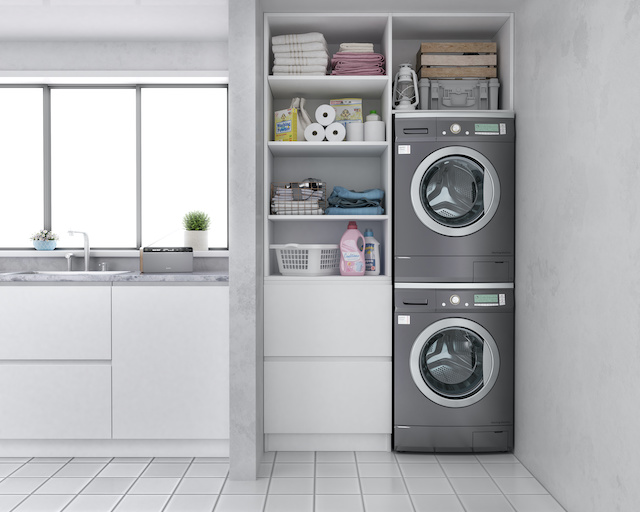Being able to wash your clothes at home is a huge convenience, but it also has a cost. For most Americans, the clothes washing and drying machines account for 10% of their total home energy use and the resulting monthly bill. Even more, if you wash your clothes in hot water, heating the water requires 75% to 90% more energy than washing in cold water. With that big slice of the pie, optimizing your clothes washing and drying is an opportunity to use less energy and reduce your electric bill. Let’s look at 13 strategies to get started.
The Washer
1. Invest in an Energy Star Machine
When you’re in the market for a new washing machine, purchase an Energy Star unit. Aside from providing the same or better clothes cleaning ability, they use 50% less water and about 25% less energy.
2. Use High Efficiency (HE) Detergent
In addition to the technological improvements in washer and dryer engineering, we’ve also made impressive strides with the soap. HE detergent creates fewer suds and requires less water to rinse clean.
3. Wash Cold
Those developments in laundry soap? They also extend to better performance in cold water. That means you can get your clothes just as clean as a hot cycle but with 90% less electricity.
4. Do a Full Load
The washing machine will use the same electricity, water, and other resources for a one-third-full load as a full load, so unless you absolutely have to wear those pants, wait until you have a full load to run a wash.
5. Skip the Sanitary Cycle
Unless absolutely necessary, skip the sanitary cycle. It’s not even an option on all machines, but where it does exist, it uses a tremendous amount more energy than the standard settings.
6. Use the Spin Cycle
Using the spin cycle won’t necessarily make your washing machine more efficient, but it will extract more water from your clothes and reduce the dryer’s work. Set it high, or let it run an extra cycle.
7. Maintain Your Machine
As time goes by, it’s not unusual for various residues to build up in the machine and impact its efficiency. Check your owner’s manual for maintenance instructions and make them part of your chore schedule.
The Dryer
8. Invest in an Energy Star Machine
Just like the washing machine, having a unit that’s specifically designed to be efficient will maximize your efforts. Some Energy Star-designated dryers have moisture sensors that result in 20% less energy used.
9. Dry Similar Items Together
One way to optimize your dryer’s efficiency is to dry like items together. Meaning that you want to dry lightweight fabrics separately from heavyweight fabrics because they’ll dry faster.
10. Use Dryer Balls
Those wool or rubber dryer balls aren’t just a gimmick. They actually really do help to separate your clothes so that airflow is increased and drying time is reduced. They’re also helpful for reducing static.
11. Use the Automatic Cycle
Nowadays, most dryers have an internal moisture sensor that can detect when the clothes are dry and stop the cycle immediately rather than letting it run longer than necessary.
12. Service Your Dryer Regularly
To keep your dryer operating efficiently (and avoid a fire), clean the lint trap after every use. And review the manual for other maintenance tips, such as wiping dryer sheet residue from the moisture sensors.
13. Don’t Use It
We’re not suggesting that you leave your clothes wet, but if you have the space and resources to dry them on a clothesline or hang them on a drying rack, it’ll do the job and won’t cost anything!
Multiple Strategies = More Efficiency
The biggest savings come from stacking tips on top of each other. In other words, using HE detergent in your Energy Star machine to wash a full load in cold water and then line drying will be more efficient than putting one or two habits into practice — but every little bit counts. Do what you can, where you can, and you should see a noticeable drop in your monthly electricity use.

